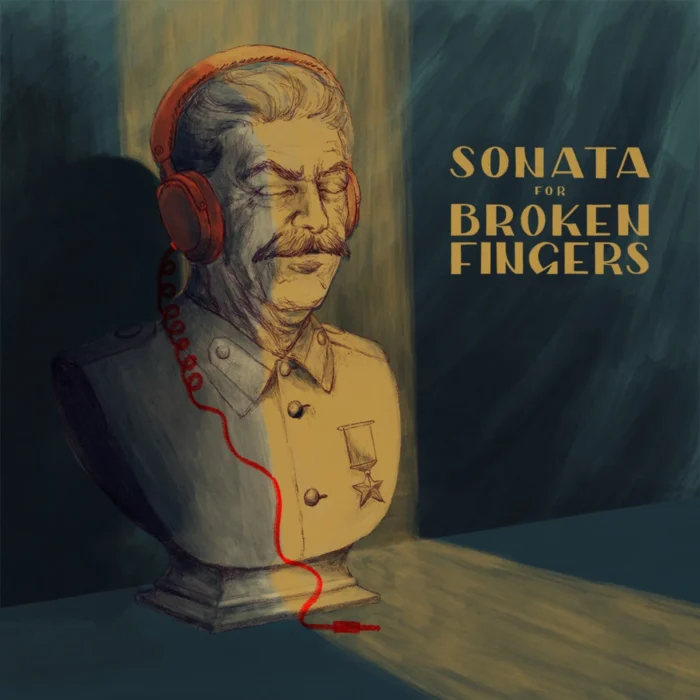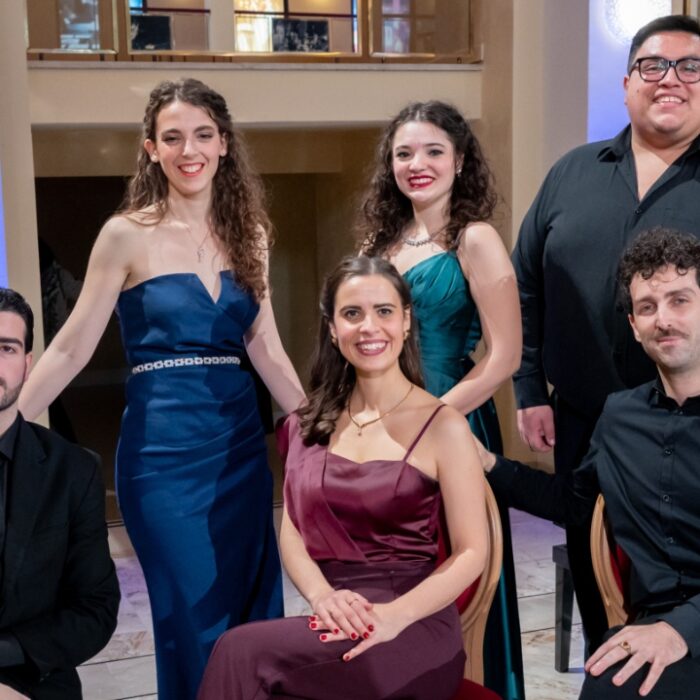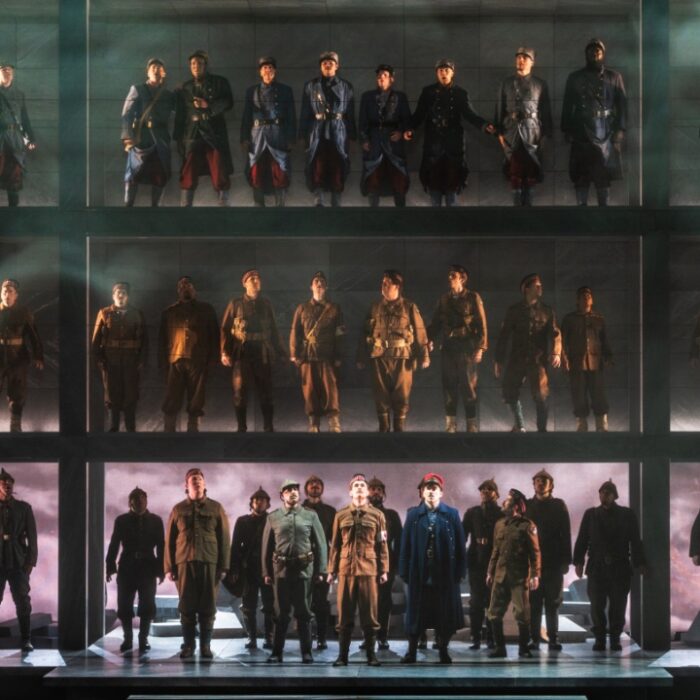
Rossini Opera Festival 2023 Review: Aureliano In Palmira
Three Standout Performances From Lupinacci, Tatarintsev & Blanch
By Alan Neilson(Photo: Amati Bacciardi)
A group of shepherds wander onto the stage. Among them are three goats being given some food to eat. There should have been four goats, but apparently one had escaped. They spent their time chewing away, seemingly oblivious to the ongoing stage movement and singing, strange surroundings of the theatre and the sound of the orchestra. At the end of this scene, they were ushered off the stage by one of the shepherds, bringing to an end the most visually exciting and imaginative scenario from Mario Martone’s production of Rossini’s 1813 opera, “Aureliano in Palmira.”
A Lackluster Reading From Martone
However, it did not have to be this way. Far from it! Giuseppe Felice Romani’s libretto, set against the background of the Roman re-conquest of Palmyra, situated in present day Syria, moves across a number of interesting and exotic locations. This includes a temple, a palace, an underground vault, a prison, a battlefield, hills, rivers and a desert. It has plenty of choral scenes for soldiers, shepherds and the populace. The characters are involved in aggressive confrontations, love scenes, stand-offs and reconciliations. There are prison escapes and rallying cries to war. It is certainly an opera with the potential for an exciting staging. Yet, the visual presentation that emerged was static and fairly monotonous, relieved only by Ursula Patzak’s colorful and imaginative costume designs.
In his program notes, Martone outlined his approach. “I desired a basic labyrinth, made up of simple elements… something recalling the economy of means marking life in the desert,” he said, while adding, “it is a conceptual staging based upon the symbols that the story places in the foreground.” And this is exactly what the scenographer, Sergio Tramonti, served up.
Tramonti’s stage designs consisted of little more than a few vertical white sheets that were occasionally rearranged or removed from which the cast would sometimes appear. There was no sense of temples, battlefields, palaces or even the desert. The back of the stage was used as a surface onto which were projected occasional images. But, these again were fairly bland in their design. The most successful image was of the moon shining wanly over the love scene between Arsace and Zenobia. Props were kept at a bare minimum. Pasquale Mari’s lighting added an extra layer of color to the scenes which successfully helped to define the changing atmospheres, although little attempt was made to conjure up the blistering heat, “marking life in the desert.” The only other feature to note was a structure hidden behind the backdrop of the stage that, when lit up, revealed a wooden “labyrinth” through which the characters occasionally moved.
This review would not have opened with what might have appeared as facetious comments about the use of live goats on stage had Martone not made them such a big issue in his program notes. In what was one of the few instances in which he grounded a scene with a sense of realism, it should not have come as a surprise that the goats were actually included for symbolic purposes. As he stated, “the Arcadian landscape I have imagined is symbolized and brought to life by the presence of some goats, left free to roam around the stage, an idea of freedom and risk expressing the prince’s state of mind… in which the action may be carried on outside preordained schemes.” It was a pity that one of the goats’ idea of freedom was not to appear on the stage in the first place and that the others had to be shepherded off the stage when the time came to exit. Putting such thoughts to one side, it was nevertheless the most visually active scene.
One final negative comment about the staging has to be made in regards to having the fortepiano placed on the stage with various degrees of exposure and having Hana Lee, the pianist, interact with the cast. Notwithstanding Lee’s excellent performance, it was distracting and added nothing to the drama at all, and when Martone’s comments are taken into account, it actually becomes absurd, if not condescending. He stated that the pianist is on stage “to stress the central position of the recitatives and the fusion of all the elements of the opera.”
On a positive note, however, Martone’s handling of the characters was excellent. Each was clearly defined, and the interactions between them were carefully moulded to bring out the depth of their feelings. This was particularly felt in the case of Zenobia and Arsace, which were sensitively and carefully developed. Also, and perhaps unintentionally, the static and dull background against which the drama took place had the effect of sharpening the focus on individual performances, and without exception, the singers seemed to rise to the task. In fact, it was the singers who stole the show.
Three First Class Leads
In the title role of Aureliano was tenor Alexey Tatarintsev, who produced a very human portrayal, albeit not a particularly attractive one, of the Roman Emperor as he followed his emotions in whichever direction they moved. In turn, he admired and pitied, raged at and hated Arsace. He loved Zenobia and was angered by her rejection, exacerbating his ire and frustrations. Yet, such was his weakness that he continued to pursue her while at the same time threatening her. Tatarintsev’s characterization was detailed and emotionally strong, expertly capturing Aureliano’s haughty, inconsistent and demanding manner. He certainly looked the part as he paced across the stage with a confident swagger. His high-lying, versatile tenor suited the Emperor’s emotional volatility as he coated the voice with his changing feelings of anger, aggression and frustration or sympathy and understanding. He pushed the voice upwards with ease, employing strong, ornate passages of coloratura, and opened up the voice splendidly to reflect his heightening emotions. His Aureliano was a man who understood the power of force and violence, even if at the end he did pardon both Arsace and Zenobia. He also realized how such an action may be used to magnify his own reputation.
Arsace was played by mezzo-soprano Raffaella Lupinacci, and it must be said that she made an excellent impression as a man of action. She certainly knows exactly how to represent male aggression and anger in an authentic manner. Her physical poses were totally convincing, and her call to arms as she rallied the troops for battle was bloodcurdling. In her confrontations with Aureliano, the force and venom with which she imbued her singing was impressive. Yet, she was equally at ease in love-making scenes with Zenobia, in which she once again showed her intuitive spectrum of the male role. It was also in these scenes that she was able to show off, to great effect, the wonderful colors of her palette. The sweet lyricism of her voice and the beauty and sensitivity of her phrasing is unmatched. This was apparent in her exquisitely delivered Act two aria “Perchè mai le luci aprimmo,” in which she imagines her life with Zenobia as peasants in the forest, away from the responsibilities of life as a noble. Alone on stage, singing on her knees, she colored with her voice a range of delicate and dark tones that conjured a sense of longing and spun out detailed, subtle phrases that oozed quality against the sympathetic orchestral accompaniment. It was a fine moment indeed, one of breathtaking beauty.
Spanish soprano Sara Blanch as Zenobia proved to be the perfect partner for Lupinacci’s Arsace. Like Arsace, she is courageous, forceful and determined, although portrayed in a feminine manner with the noble bearing of a queen. Confrontations with Aureliano were energetic and tended to be sparky affairs, while the love scenes with Arsace were sensitively moulded to create a convincing pairing of a couple in love. She possesses an attractive voice with a bright, ringing upper register, which she used to soar easily above the orchestra without any sense of stress. Her top notes had a bell-like clarity. Her complex coloraturas were wonderfully crafted and dispatched with confidence and verve. Leaps presented no problems, and her ability to spin out long, detailed lines was beautifully accomplished.
Duets and ensembles play a significant and important role in the opera’s musical and dramatic scheme, and the three principal singers ensured that they were all given strong performances. Whether it was a love duet for Arsace and Zenobia, a confrontation duet between Aureliano and Zenobia or Arsace, or a trio or a quartet, the voices were always well balanced and contrasted nicely with each other to create wonderful vocal textures. They were also emotionally strong. Lupinacci and Blanch were a brilliant combination. Their voices seemed naturally attuned to each other, giving the impression of emotional compatibility. On the other hand, the duets between Tatarintsev and Blanch or Lupinacci sizzled with friction.
Mezzo-soprano Marta Pluda as Publia, the daughter of the late Emperor Valerian who also happens to be in love with Arsace, produced a poised and confident performance. This included her pleasing and carefully presented rendition of her Act two aria, “Non mi lagno che il mio bene.”
Bass Alessandro Abis made an excellent impression as the Gran Scaredote. His Act one aria, “Stava, dirà la terra,” allowed him to show off his resonant and clearly articulated voice in what was an authoritative, confident performance.
Bass Davide Giangregorio possesses a distinctive, refined voice with a pleasing timbre that lies easily on the ear. Under-parted in the relatively small role of the tribune Licinio, he nevertheless managed to catch the attention of the audience with his strong performance.
Tenor Sunnyboy Dladla as Oraspe produced a forceful, energetic performance in which he sang with a lively, clear voice.
Baritone Elcin Adil, cast in the small role of a shepherd, gave a good account of himself.
The Coro del Teatro della Fortuna, under the direction of Mirca Rosciani, sang well in all the roles, and took up pleasing static positions on the stage to help create some attractive tableaux. The limited choreography meant there was little movement.
Petrou Shows His Worth
Later reused for “Il Barbiere di Siviglia,” the overture for “Aureliano in Palmira” is one of Rossini’s best-known pieces, and it was not given a particularly successful reading by the Orchestra Sinfonica G. Rossini. The sound was sluggish. There was no dash or brio, nor did it possess a military briskness. The musical contours were weakly delineated. Reports from the premiere three nights earlier suggested there were intonation problems, and it was likely the labored response was an attempt at putting things right, with the result that spontaneity was sacrificed for precision.
The conductor, George Petrou, however, soon put things in order. His energetic and animated leadership quickly invigorated the orchestra, so that within a short period of time it was playing with a greater degree of freedom and more emotional commitment. The music flowed easily and in line with the dramatic movements of the text. The labored approach evaporated. Dynamic and textural contrasts were clearly highlighted. The connection between singers and orchestra was pleasingly balanced.
On reflection, it is clear that the staging did not add up to much. It was, for all intents and purposes, only a couple of steps removed from a concert performance. The colorful costumes helped create some attractive tableaux, but they were not enough on their own to significantly enhance the drama. In defense of the director, the production was scheduled for the much smaller stage of the Teatro Rossini, which was closed owing to earthquake damage. It is possible that it would have been more successful in its more intimate surroundings. The evening, however, was saved by the splendid singing of the three principal singers, Lupinacci, Blanch and Tatarintsev. They were supported by the strong direction of Maestro Petrou, who, after a few teething problems, managed to effectively illuminate the orchestra.



